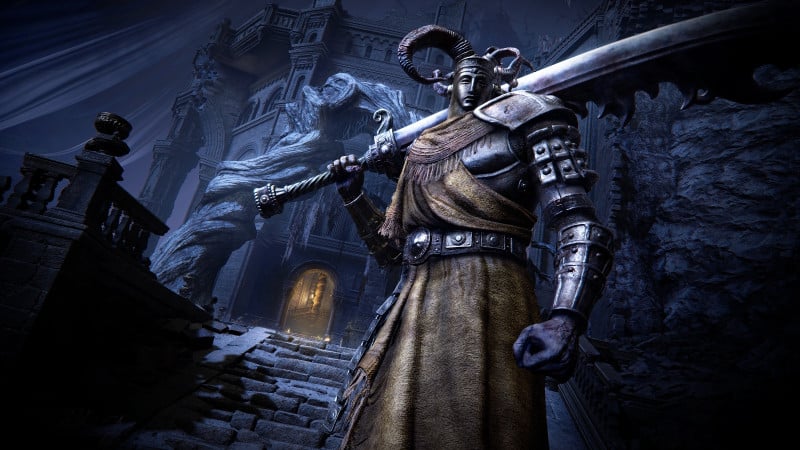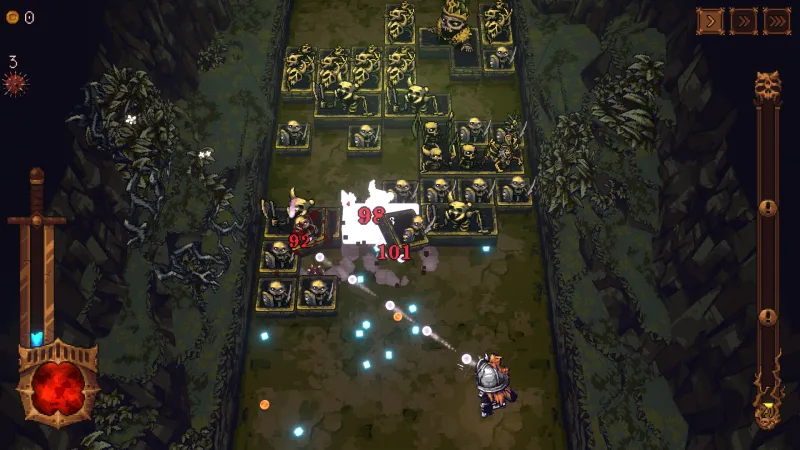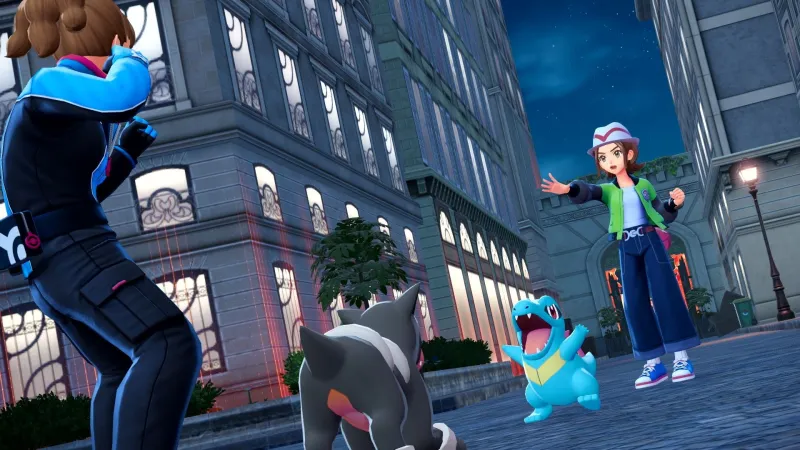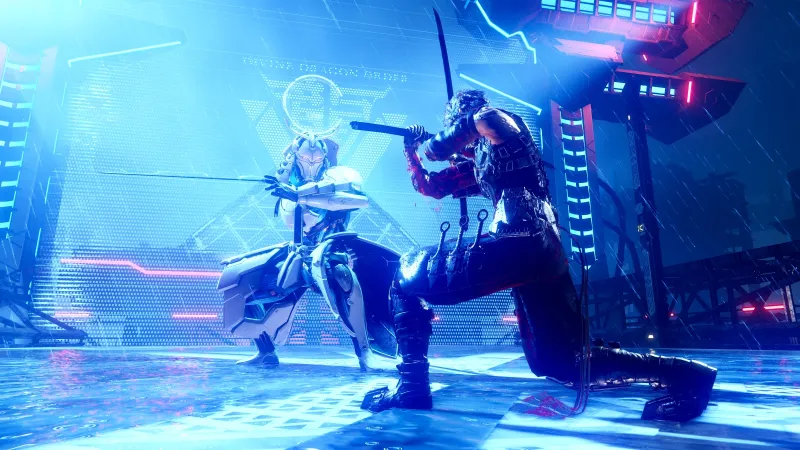I love Elden Ring. I played it for more than 150 hours. It was also my 2022 game of the year by a nautical mile. I loved it so much that I wrote a whole piece on having what I dubbed “post-Elden Ring depression.” That’s why its upcoming expansion, Shadow of the Erdtree, has been among my most anticipated games of 2024 and why I couldn’t wait to fly out to Los Angeles to play the first hands-on demo. Taking place in a special venue in the heart of the famous Hollywood Forever Cemetery (you read that right), I spent three hours freely roaming a portion of the new map, The Land of Shadow, faced a slew of unsettling new foes, battled two major bosses, wielded new weapons, and caught hints of the grander story at large. Those three hours flew by; Shadow of the Erdtree is a blast, and I can’t wait to explore more.
Beginning Shadow of the Erdtree requires players to defeat Starscourge Radahn and Mohg, Lord of Blood. My first order of business is to choose a pre-made, late-game character occupying one of three classes: Warrior and the new Knight and Sorcerer roles. I choose the Warrior as it best fits my dexterity-focused playstyle, and my demo begins in Mohgwyn Palace, standing before the cracked cocoon of Miquella the Kind, brother of Malenia. Greeting me is a new face named Furled Finger Needle Knight Leda, who instructs me to touch Miquella’s shriveled, blood-soaked arm hanging lifelessly from the cracked opening. I comply and am transported to The Land of Shadow to begin my new journey.
A New Open World
The Land of Shadow is immediately eye-catching. I enter an expansive grassy field dotted with ghostly tombstones and ancient stone arches; this portion of the map appears like a giant cemetery, explaining the event’s venue. The massive Erdtree stands prominently at the center, and its canopy is draped in an ethereal blanket, with cloth-like folds flowing across the orange-tinted sky. I immediately spot one of the imposing, lumbering fire basket giants seen in the trailers and make a mental note to try my luck against it.
My main objectives are heading towards the Beirut Castle Settlement in the west or tackling Castle Ensis in the east. I take a few steps before being assaulted by new enemy types, such as a masked agile warrior dual-wielding a pair of ring blades and large, masked birds atop perches that spew a barrage of black fireballs. I take them down with my warrior’s arsenal of a one-handed axe, which I often lobbed at enemies to deal satisfying damage, and, my favorite, the Red Bear Hunt melee glove. This furry weapon resembles a bear’s claw and unleashes a frenzied flurry of attacks that makes me feel like a one-armed Wolverine. I use its speed to overwhelm and stagger foes before they can retaliate. This is a sliver of the arsenal Shadow of the Erdtree offers; Bandai Namco confirms the expansion introduces 100 new weapons, and you can use these weapons in the base game’s content, too.
I head southeast and find a path guarded by soldiers, including heavier units brandishing large maces and a door-sized shield. Fighting through them takes me to the Church of Consolidation, a small ruin where I find one of Shadow the Erdtree’s new upgrade items, the Scadutree Blessing. Visiting a Site of Grace introduces a new option to upgrade your Scadutree Blessing, making you more resistant to physical damage and generally sturdier. I upgrade this stat once, and the next upgrade now requires two Scadutree items. Another equivalent item I find soon after does the same for your Spirit Ashes. Bandai encourages us to hunt for these upgrades to improve our odds should we find ourselves stuck against a formidable foe. Unlike the new weapons, the beneficial effect of Scadutree Blessing only applies to areas within Shadow of the Erdtree; it does not carry over to the main game. Of course, you can still upgrade your character in the traditional manner.
I approach a cliff and gaze at a large, distant land mass far below. It’s much too steep a drop to survive a jump, and I don’t see any obvious path down to it. However, this area has another fire giant stomping around, confirming it’s explorable. This zone’s most notable landmark is a dead dragon sporting a sizable, hollowed-out chest cavity. I have no idea if this landmass is reachable or not in this demo build, but it’s a tantalizing reminder that Shadow of the Erdtree likely has more to it than meets the eye.
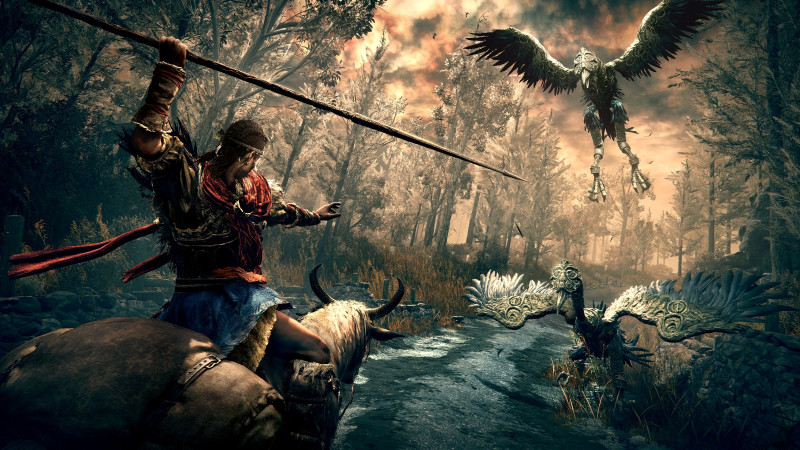
Hopping atop Torrent, I head back towards where I started through a charred complex appropriately named the Scorched Ruins. Charcoal-black lethargic spirits stumble all around this spot, but don’t be fooled; several of them brandish daggers and lunge towards me if I approach too closely. They’re extremely weak, though, and are dispelled with one or two swings from my bear claw. After exiting and finding a new Site of Grace, I spot the fiery basket colossus I saw earlier. It’s enormous, but that doesn’t dampen my enthusiasm to test my mettle against it. I beckon Torrent and charge towards one of its redwood-sized legs and take a big swipe with my axe – it does, at best, maybe five points of damage. “I’ve f***** up,” I think to myself. Sensing my mosquito-bite caliber attack, the giant goes berserk, kicking massive, flaming boulders from the earth, which I narrowly avoid. I’m not so lucky when it slams the ground to unleash a wide-reaching flame burst that incinerates Torrent, leaving me stranded on foot and falling victim to another hail of magma rocks that does me in. Note to self: steer clear of these things for the foreseeable future.
I reach a fork in the road called Three Path Cross, highlighted by a tall column of light with a circular symbol at the tip – a symbol of Miquella. Touching this “cross” only displays a message: “I abandon here the first of the flesh of my own body.”
Two characters stand beside the cross. One is a warrior named Freja, who tells me she once fought alongside Radahn. She informs me the crosses are Miquella the Kind’s footprints and that there are several of them across The Land of Shadow. To find the others, I’d need to talk to the surly character standing nearby to receive a map of their locations. I do just that, and the masked man isn’t a big fan of Tarnished but is compelled by duty to help, providing the map while urging me to continue following Miquella’s trail by finding the other crosses.
I head towards Beirut Castle Settlement, situated atop an elevated plateau. I see another cross and two more characters surrounding it. Touching this cross displays the same message (I later learn that they all do), and I speak to an old, grizzled former servant of Mohg who offers what I assume to be a sidequest: if I find other footprints of Miqella, please inform him. However, I’m unsure how to fulfill this as I’m never given the option to tell him of the first cross I found. The other character sitting nearby is a friendly knight and merchant. I stock up on a few supplies and climb towards Beirut Castle Settlement to take on my first boss.
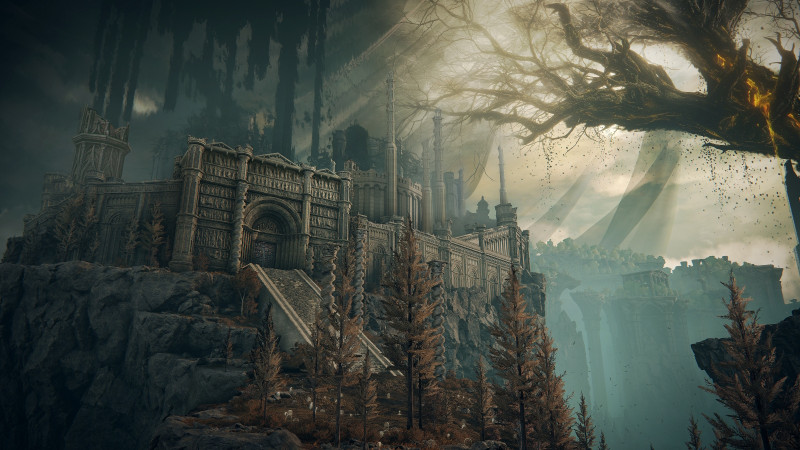
Beirut Castle Settlement
I climb the steps towards the entrance of this large, abandoned castle complex. The vestiges of its beauty shine through its crumbling exterior thanks to its terracotta-tiled roofs and ornate cloths blanketing most buildings. It also boasts aquatic features such as decorative fountains and even a natural waterfall the city appears to be built around.
Despite this zone’s beauty, I’m unexpectedly assaulted by a terrifying sight: a gigantic, scorpion-esque arachnid sporting way too many eyes, crushing pincers, and a stinger tail that fires a poisonous goo. Most bugs don’t creep me out, but this thing scared the crap out of me; it’s a new example of From Software’s trademark unsettling enemy design.
Taking it down isn’t too difficult, however; this creature is especially susceptible to my axe throw, which lets me keep my distance. Unfortunately, it won’t be the last time I encounter these things. Entering and exploring the city proper gives me the fun, interconnected level design From Software excels at. There are numerous paths, including taking to the rooftops, locked gates in need of keys, such as a door to a hidden sewer route. More blackened spirits occupy the area, including a much larger, more powerful variant sporting a giant blade. Taking these down is much harder, especially against more than one. They reduce sizable portions of my lengthy health bar with just a couple of swings.
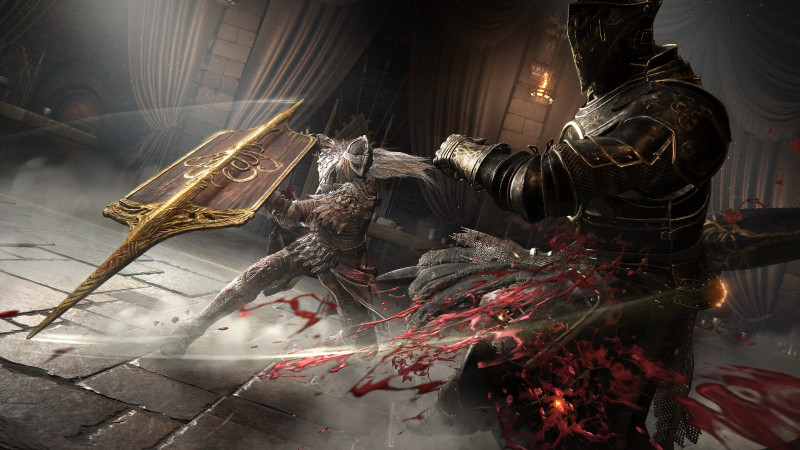
The toughest enemy I encounter is a towering, twin-sword-wielding knight clad in beautiful gold armor. Despite its size, it’s extremely fast and unleashes a whirlwind of sword slashes that eviscerate me several times as I attempt to defeat him. Admittedly, I take advantage of the geometry by luring him down a staircase in a narrow room and trapping him in a corner, where I slowly shave off his health by firing arrows from a safe distance above. But a win is a win.
Advancing through the castle is a challenging but deeply engrossing exercise in trial and error. I push past one threat only to enter a room filled with more giant scorpion bugs, including smaller baby versions. Several of the masked birds I fought in the overworld sit atop perches, daring me to get close enough to draw their wrath. At one point, I enter a small, intimate plaza only to be invaded by a blond-haired fire knight sporting a flaming great sword. If that’s not enough, he can shoot fireballs and execute a fatal flaming rising sword attack. This guy is basically a medieval Ken of Street Fighter fame. I spend a good chunk of time trying to take him down, and after several attempts, I’m victorious. My reward: the fire knight’s sword, a heavy weapon that not only dishes out great damage with sizable reach but also ignites foes upon impact. It becomes my primary weapon for the remainder of my session and is an effective answer to many of the threats here.
Another element of Beirut is poisoned rivers streaming through certain parts of the area. Wading through these zones invites attacks from poison-spewing winged insects that look like a hybrid between a cricket and a crone. Whatever they are, they’re disgusting, and I’m more than happy to exterminate them with my flame sword.
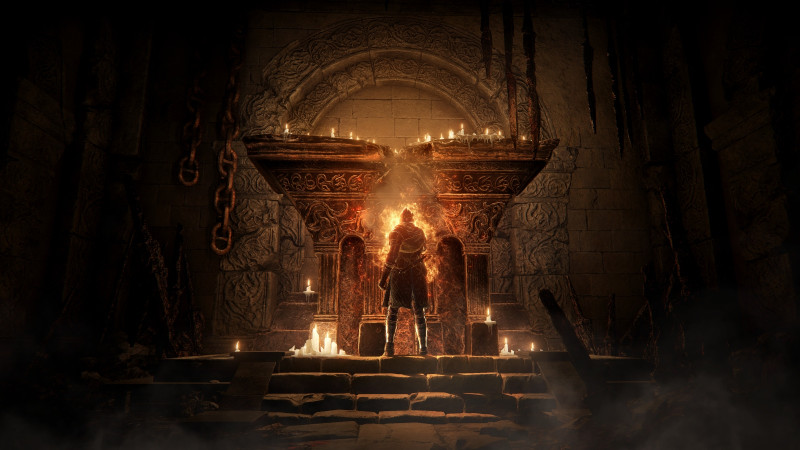
After nearly an hour of exploration (where I definitely didn’t find everything Beirut has to offer), I fight my way up to the top of the complex and to the doorstep of the area’s boss. I take advantage of a summoning glyph before the door for extra help and initiate the battle against my first big test, Divine Beast Dancing Lion. This lion looks and moves less like a living creature and more like a parade float or elaborate theater costume. Its bulky proportions, long cloth draping over its body, and segmented body movements give the impression of being controlled by several humans hiding underneath its folds. It leaps and spins in a chaotic flurry, first by digging into the earth to unleash wide-reaching blasts of rocks and dirt.
As I chip away at its health, the sky darkens, and the lion transitions to summoning lightning bolts from the heavens. Later, it shifts again to conjuring blizzard-like frost-based offense. This constant shift in elemental attacks and its relentless, erratic movements make the Lion a tough target to track. Combined with the dazzling and disorienting visual effects of its elemental attacks, visually parsing this battle is a challenge in and of itself. I begin to find my bearing after several attempts, getting closer and closer to victory before falling short. Unfortunately, I’ll have to wait to avenge my many defeats. I only have an hour left in my session and still have another castle to explore.
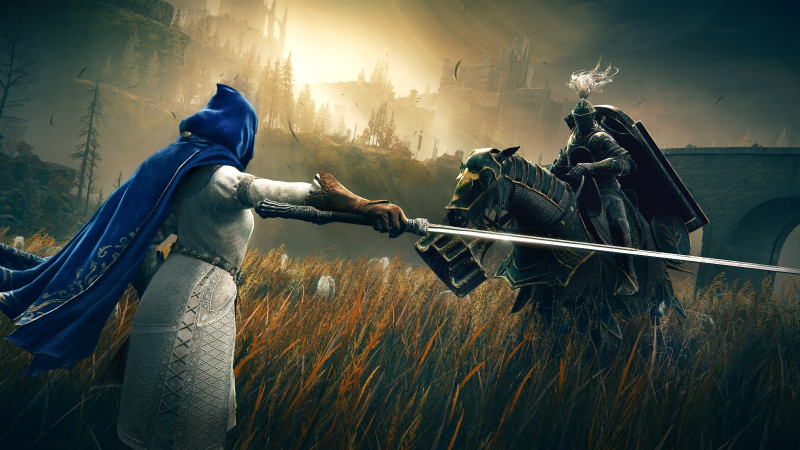
Castle Ensis
I fast-travel back to the Three Path Cross and head in the opposite direction toward Castle Ensis. The only entry point (that I find, at least) is a long, towering bridge guarded by soldiers. I make quick work of them without even getting off my steed.
The road ahead is a literal uphill climb across a few barracks, where I’m greeted by other guards, their ferocious hounds, and the teleporting wizards taking magical potshots from afar. I even encounter a few bobblehead-esque Raya Lucaria masked sorcerers who seem to have taken up residence within Castle Ensis. Due to time constraints, I more or less beeline my way through this area, so I’m unable to poke around searching for hidden paths and secrets.
I hit a roadblock in the form of a particularly powerful knight who imbues his large sword with magical energy while conjuring spectral blades to attack from afar. Despite a few attempts, he bests me each time. I’m forced to swallow my pride and sneak past him in order to reach Castle Ensis’ boss.
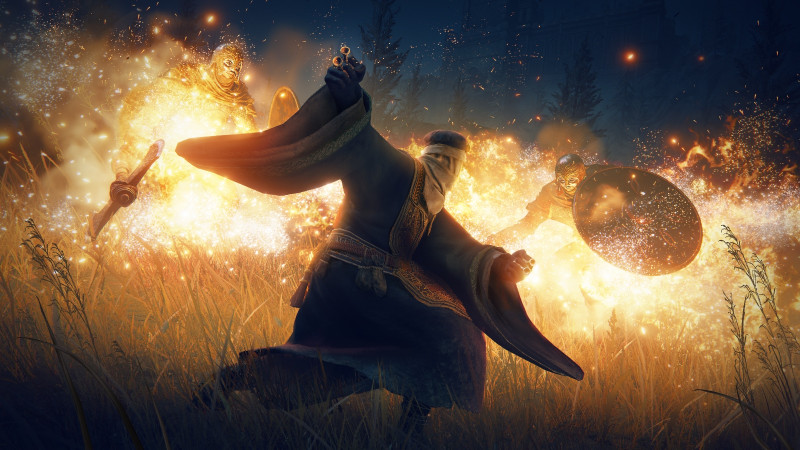
Unfortunately, that knight is a mild appetizer for what awaits players. I reach the door housing the boss and am surprised to see not one, but two NPC summons. “That’s generous,” I think to myself. Combined with my own spirit ashes, I can roll up on this boss with a posse of four fighters, myself included. Surely, this will be a relative cakewalk. I couldn’t be more wrong. Standing on the other side of the door is an imposing, armored warrior named Rellana, Twin Moon Knight. Spoiler: she wipes the floor with us. Despite basically having a full RPG party, our combined efforts deal modest damage to her sizable health bar. In retaliation, she unleashes a devastating yet graceful flurry of magic-imbued offense courtesy of her twin blades. She also moves across the arena with astonishing speed, quickly closing the gap on me no matter how much distance I try to put between us. Each battle ends quickly, and I can only last by standing back and letting my companions serve as distractions while I take the occasional cheap shot.
The one time I manage to get Rellana to almost half her health, she raises the stakes by powering up her swords; one blade glows with the blue of magic, the other in fiery red flames. It’s academic at this point; she ends me so swiftly that I barely get to study her new form. I’m forced to tap out yet again. Rellana is a new example of the dreaded FromSoftware DLC boss; that is, a foe more challenging than perhaps any adversary in the base game.
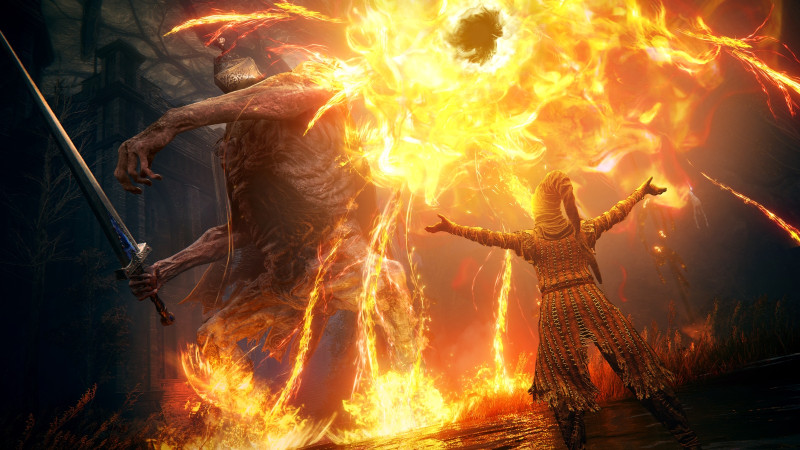
Back in the Wild
I depart Castle Ensis and spend my remaining few minutes exploring. I head towards a small lake, encountering a new, seemingly undead dragon roaming the area. Since I failed to take down the two major bosses, I decide to make this black and tattered-looking beast my trophy for the day. The fight is largely identical to the other dragon battles in the main game, and I slay it on the first attempt. At least I have something to brag about.
I don’t do much else of note before my session expires. As much fun as I had, it was even more exciting talking to other journalists about their experiences. Besides learning who could slay the two primary bosses and how, each person I talked to tells me of a discovery they made, whether it’s a location, character, or enemy I didn’t find. I won’t spoil anything I heard, but all of it was deeply exciting and also deeply strange. From Software has billed Shadow of the Erdtree as the biggest expansion it has ever created, and given that I rarely heard repeat discoveries from the people I talk to, I’m inclined to believe it.
My biggest takeaway from Shadow of the Erdtree is that – surprise – it’s more Elden Ring. It’s the most unexciting take imaginable, but outside of the intriguing yet not immediately noticeable wrinkle added by the Scadutree upgrades, it’s a new excuse to revisit a world I love. It’s tough to get a sense of the expansion’s narrative implications and to be honest, that’s the last thing I care about in this game, as interesting as its lore is on the surface. All I want is to experience a new gauntlet of trials and surprises, and Shadow of the Erdtree seems poised to deliver that and then some.
Elden Ring: Shadow of the Erdtree launches for all platforms on June 20.



